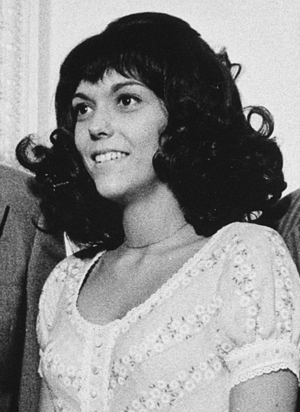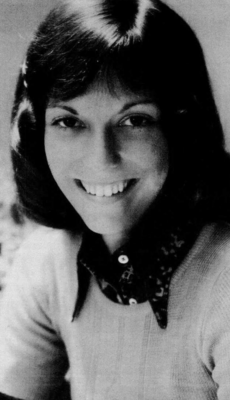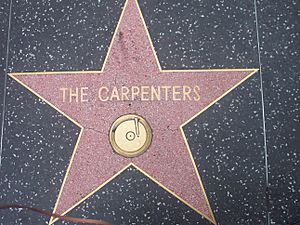Karen Carpenter facts for kids
Quick facts for kids
Karen Carpenter
|
|
|---|---|

Karen at the White House in 1972
|
|
| Background information | |
| Birth name | Karen Anne Carpenter |
| Born | March 2, 1950 New Haven, Connecticut, U.S. |
| Origin | Downey, California, U.S. |
| Died | February 4, 1983 (aged 32) Downey, California, U.S. |
| Genres | |
| Occupation(s) |
|
| Instruments |
|
| Years active | 1968–1983 |
| Labels | A&M |
Karen Anne Carpenter (born March 2, 1950 – died February 4, 1983) was an American singer and drummer. She was one half of the famous music group The Carpenters, along with her older brother Richard. Karen was known for her amazing singing voice, which could reach three octaves. Many other musicians admired her vocal skills.
Karen was born in New Haven, Connecticut. Her family moved to Downey, California in 1963. She started learning to play the drums in high school. After graduating, she joined the choir at Long Beach State. After touring and recording for several years, The Carpenters signed with A&M Records in 1969. They became very successful throughout the 1970s.
At first, Karen was the main drummer for the band. But over time, she became the lead singer. Her drumming was then mostly for live shows or a few songs on albums. As she became more famous, people often commented on her appearance. She developed anorexia, an eating disorder, as a way to deal with the pressure to be thin.
Karen Carpenter passed away at age 32 from heart failure. This was caused by complications from her anorexia. At the time, not many people knew about eating disorders. Her death helped bring more attention and understanding to these conditions. Her music and life continue to inspire many. In 2010, Rolling Stone magazine listed her among the 100 greatest singers of all time.
Contents
Karen's Early Life
Karen Anne Carpenter was born on March 2, 1950. She was born at Grace New Haven Hospital in New Haven, Connecticut. Her parents were Agnes and Harold Carpenter. Her father, Harold, was born in China. He went to boarding schools in England before working in printing.
Karen's older brother, Richard, was three years older. He loved music from a young age and was a talented piano player. Karen enjoyed dancing and took tap dancing and ballet classes when she was four. She also liked playing softball on the street.
In June 1963, her family moved to Downey, California. Karen started Downey High School in 1964 when she was 14. She joined the school marching band to avoid gym class. Her band conductor, Bruce Gifford, gave her a glockenspiel. Karen didn't like it.
She admired her friend Frankie Chavez, who played the drums. Karen asked if she could play the drums instead. She wanted a Ludwig drum set, like her favorite drummers Joe Morello and Ringo Starr. Frankie helped her family buy a Ludwig kit. He then taught her how to play. Karen practiced every day. Within a year, she could play complex rhythms, like the 5/4 time in Dave Brubeck's "Take Five". She also took lessons from jazz drummer Bill Douglass.
Karen was shy about performing at first. But she said she was "too involved in the music to worry about it." She finished high school in 1967. She then studied music at Long Beach State. There, she sang in the college choir with Richard. Karen became more confident in her singing. She took lessons with Frank Pooler, the choir director. He helped her develop her voice. Pooler later said Karen was a "born pop singer." By age 17, her voice was "a remarkable instrument."
Starting a Music Career
Early Bands and Discoveries
Karen and Richard's first public performance was in a local play called Guys and Dolls. Karen's first band was Two Plus Two, an all-girl group. In 1965, Karen, Richard, and their friend Wes Jacobs formed the Dick Carpenter Trio. They played jazz in nightclubs. Richard was amazed by Karen's drumming skills. She didn't sing with this group at first.
In April 1966, Karen and Richard had an audition with bassist Joe Osborn. He was a famous studio musician. Karen was expected to only play drums. But she tried singing and everyone was impressed by her unique voice. Osborn signed Karen to his record label, Magic Lamp Records.
In 1967, Wes Jacobs left the trio. Karen and Richard wanted to try new music styles. They formed a group called Spectrum with other musicians. They focused on singing together in harmony. They made many demo tapes, but record companies often rejected them. Their sound was different from the popular hard rock music at the time.
In 1968, the Dick Carpenter Trio appeared on a TV talent show. They performed "Dancing in the Street" with Karen singing and playing drums. The trio won the show's finals that year.
The Carpenters Group
A&M Records signed The Carpenters in 1969. Karen started as both the drummer and co-lead singer. She sang most of her songs from behind the drum set. She sang most of the songs on their first album, Offering. This album was later renamed Ticket to Ride. Karen also played bass guitar on two songs. She played drums on "All I Can Do" in a complex 5/4 time. The song "Ticket to Ride" was their first single. It reached No. 54 on the Billboard charts.
Their next album, Close to You (1970), had two big hit songs. These were "(They Long to Be) Close to You" and "We've Only Just Begun". They reached No. 1 and No. 2 on the charts.
Because Karen was not very tall, it was hard for audiences to see her behind the drums. After some reviews, Richard and their manager suggested she stand at the microphone to sing. Another musician would play the drums. Karen felt more comfortable behind the drum kit at first. But she gradually became the main focus of their shows and albums. She would sometimes perform a drum solo on stage. Her voice was recorded very well in the studio. Even though she had a three-octave range, many of their hits used her lower voice. She joked, "The money's in the basement."
Karen always saw herself as a "drummer who sang." She loved Ludwig Drums. However, she did not play drums on every Carpenters recording. She was the only drummer on their first album, Ticket to Ride. For many studio recordings, famous session drummer Hal Blaine played the drums. Karen and Richard were fine with this. Blaine praised Karen's drumming skills. But he believed her greatest talent was her singing.
The Carpenters often canceled tours. They stopped touring completely after a concert in Las Vegas in 1978. In 1980, Karen sang a duet with Ella Fitzgerald on a TV show. In 1981, after their last album Made in America, they did some promotional tours.
"Now" was the last song Karen recorded, in April 1982. Richard thought her voice still sounded amazing.
Solo Music
Karen released her first solo song, "Looking for Love", in 1967. Only 500 copies were made. In 1979, while Richard took a break, Karen started recording a solo album in New York. The music was different from The Carpenters' usual style. It was more upbeat and showed off Karen's higher voice.
However, her brother Richard and the record company did not like the album. It was put aside and not released at that time. The company even charged Karen $400,000 for the recording costs.
Some songs from her solo album were released in 1989 on The Carpenters' album Lovelines. The complete solo album, called Karen Carpenter, was finally released in 1996. Critics said it was a good album for its time.
Karen's Personal Life
Karen had a close but sometimes difficult relationship with her parents. They had hoped Richard would become a musician. They were not fully ready for Karen's success. She lived with them until 1974. In 1976, Karen bought two apartments and combined them into one. Her doorbell played the opening notes of "We've Only Just Begun."
She collected Disney items. She also loved playing softball and baseball. She was a big fan of the New York Yankees. In the early 1970s, she became a pitcher on a celebrity softball team.
Her celebrity friends included Petula Clark, Olivia Newton-John, and Dionne Warwick. Karen was a successful female drummer in a male-dominated field. However, her views were not aligned with the women's liberation movement. She believed a wife should cook for her husband.
Karen often said she wasn't interested in marriage because of constant touring. In 1976, she said the music business made it hard to meet people. She didn't want to marry just for the sake of it. But she told Olivia Newton-John that she wished for a happy marriage and family. She dated several famous men.
On August 31, 1980, she married real-estate developer Thomas James Burris. He was nine years older and had a son. A new song, "Because We Are in Love," was played at their wedding. The couple lived in Newport Beach.
Their marriage lasted only 14 months. Friends said Burris spent too much money and borrowed from Karen. Her close friend Karen Kamon said the marriage was "the straw that broke the camel's back." In September 1981, Karen changed her will. She left her home to Burris but everything else to her brother and parents. She filed for divorce in October 1982.
Health and Passing
On February 4, 1983, Karen collapsed at her parents' home in Downey. She was taken to Downey Community Hospital and passed away at 9:51 a.m. She was 32 years old.
Karen's funeral was held on February 8, 1983. About one thousand people attended, including her friends Dorothy Hamill, Olivia Newton-John, Petula Clark, and Dionne Warwick. Her estranged husband, Thomas Burris, also attended. Karen was buried in Cypress, California. In 2003, her body was moved to a private mausoleum in Westlake Village, California.
Karen's Legacy and Impact
Karen Carpenter's singing has been highly praised. She has influenced many famous musicians like Madonna, Sheryl Crow, and Shania Twain. Paul McCartney said she had "the best female voice in the world." Elton John called her "one of the greatest voices of our lifetime." Her friend Nicky Chinn said that John Lennon once told her, "I want to tell you, love, that you've got a fabulous voice." Her drumming skills were also praised by other musicians and Modern Drummer magazine.
On October 12, 1983, The Carpenters received a star on the Hollywood Walk of Fame. In 1999, VH1 ranked Karen No. 29 on its list of the 100 Greatest Women of Rock and Roll. In 2010, Rolling Stone ranked her No. 94 on its list of the 100 Greatest Singers of All Time. They described her voice as "impossibly lush and almost shockingly intimate."
Karen's passing brought a lot of media attention to conditions like anorexia nervosa. Before this, the condition was not widely known. Her family started the Karen A. Carpenter Memorial Foundation. This foundation raised money for research on anorexia nervosa and other eating disorders.
Fans sometimes call Karen "Lead Sister." This nickname came from a Japanese journalist in 1974 who mispronounced "lead singer." Karen later wore a T-shirt with this nickname during live shows.
Books and Movies About Karen
A 43-minute film called Superstar: The Karen Carpenter Story was released in 1987. It used Barbie dolls as the characters. The film was later removed from circulation due to a copyright lawsuit.
On January 1, 1989, a TV movie called The Karen Carpenter Story aired on CBS. Cynthia Gibb played Karen. This movie helped bring back interest in The Carpenters' music.
Richard Carpenter helped create documentaries like Close to You: Remembering The Carpenters (1997) and Only Yesterday: The Carpenters Story (2007).
Randy Schmidt wrote a biography about Karen called Little Girl Blue in 2010. It included interviews with her friends. The New York Times called it "one of the saddest tales in pop." In 2021, Chris May and Mike Cidoni Lennox published Carpenters: The Musical Legacy. This book included rare photos and new stories about the band.
Karen Carpenter's Music Albums
Studio Albums with The Carpenters
- Offering (1969)
- Close to You (1970)
- Carpenters (1971)
- A Song for You (1972)
- Now & Then (1973)
- Horizon (1975)
- A Kind of Hush (1976)
- Passage (1977)
- Christmas Portrait (1978)
- Made in America (1981)
Albums Released After Her Death
- Voice of the Heart (1983)
- An Old-Fashioned Christmas (1984)
- Lovelines (1989)
- As Time Goes By (2001–2004)
Karen's Solo Albums
- Karen Carpenter (1996), recorded 1979-1980
Karen's Solo Songs
- "Looking for Love" (1966)
- "If I Had You" (1989)
- "Make Believe It's Your First Time" (1996)
Movies and Documentaries
- The Karen Carpenter Story (1989 TV movie), directed by Joseph Sargent
See also
 In Spanish: Karen Carpenter para niños
In Spanish: Karen Carpenter para niños




